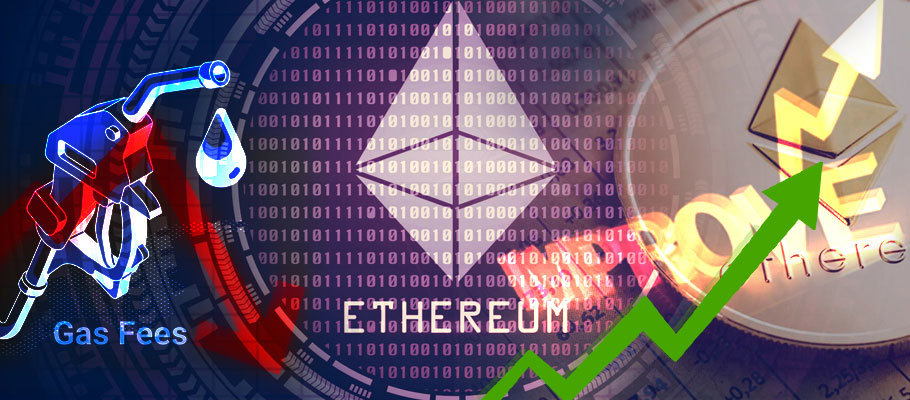
Published: August 27th, 2021
Bundled inside Ethereum's long-awaited ‘London’ hard fork is a network improvement proposal that aims to fix the blockchain’s persistent problems with congestion and the high transaction fees designed to manage it.
It's a big change for the world’s number two blockchain, and one that's already sent crypto markets buzzing. But what should Ethereum users and ETH traders look for as the hard fork rolls out over the coming days?
Officially labelled EIP-1559, the proposal aims to improve Ethereum's transaction fees by making them more predictable. Removing fee uncertainty means users can make purchases or trade crypto without worrying that transactions will be pushed to the back of the approvals queue if their gas prices are set too low.
EIP-1559 is designed to shorten the wait time per transaction and create a more seamless user experience for the Ethereum community and its small universe of decentralised apps, or ‘dapps.’
The changes will be built on two core elements. First is the minimum gas price required for transactions, called the BASEFEE. The second is a new way of regulating fee levels, which rise when network congestion is high and drop back when it's quiet.
The difference between the new and current systems is that miners will no longer set the rates. They’ll be determined automatically by an algorithm. That should establish more fee stability throughout the Ethereum ecosystem.
Interestingly, EIP-1559 makes fees irrelevant to miners by burning the ETH mining fees generate. Instead, there will be an ‘inclusion’ fee, effectively a tipping system that allows users to top-up the base fee to prioritise their transactions over others. That will be the new income source for miners.
While the proposal aims to minimise gas price volatility, it can’t guarantee lower rates because Ethereum’s saturated blocks can only manage a limited number of transactions. Under the proposal, fees (before inclusion fee tipping is accounted roe) can only go up or down by 1.125x for each block. The point of that rule is to establish greater stability and predictability for transactions.
That's a crucial point, because gas price uncertainty has tended to limit the adoption and scalability of Ethereum-based dapps. Since Ethereum is the leading dapp and blockchain developer ecosystem, EIP-1559 could help fend off ETH ‘killers like Solana and Polkadot, undercutting their promises of lower fees and speedier transaction processing.
Bitcoin enthusiasts say one of its key strengths is its built-in supply cap of 21 million coins. The supply of Ethereum is technically unlimited, or it was before the London fork kicked in.
At the moment, every new block mined on Ethereum generates two additional coins which go straight into circulation. That continuous influx of coins (the current annual issuance rate is four per cent) dilutes Ethereum’s value.
Under EIP-1559, the ‘burning’ of new coins generated by mining will remove coins from circulation after any new ones are issued, automatically zero-summing any increased supply of ETH.
If future bull markets take hold or an extended period of high network activity arrives, the total amount of ETH burned could exceed the amount of new ETH issued through block rewards. That could create a steady, gradual decline in the supply of Ethereum, potentially raising its value.
Critics, however, note that burning and counterbalancing supply could create a different kind of economic instability since it's hard to accurately predict what the total amount of ETH in circulation will be at any given time.
Most Ethereum mining fees are paid in ETH, but there’s nothing technically stopping miners from taking other forms of crypto as payment. There’s actually a built-in incentive for users to pay miners in a coin other than ETH because it means they can get their transaction added in the next block for a total gas fee of zero. It’s basically a backdoor tactic to minimise the transaction spend.
The EIP-1559 proposal will stop all that. The network base fee will have to be paid in ETH in order for a transaction to be validated. While a miner would still be free to accept an alternative crypto to prioritise a user's transaction, the core base fee would still have to be cleared in ETH for it to be included in an Ethereum block.
That fortifies Ethereum's utility as a way to smooth network transactions. Altogether, the update will help Ethereum fill the gaps and in its ecosystem, much like Apple built a complementary infrastructure around iOS devices.
As with any software update, bugs and glitches are an ever-present threat. Weaknesses in code can reveal exploits and lead to malicious behaviour by users looking to profit from vulnerabilities.
There’s also potential for pushback from miners upset that their revenue streams are being disrupted. After EIP-1559 is rolled out, miners who upgraded their client software early will start producing blocks automatically under the new fee structure. Those who didn’t will continue mining the older version of Ethereum.
That sort of split is known as a ‘contentious’ hard fork. When these conflicts have popped up in the past, they led to trouble. In 2017 the Bitcoin network split over disagreements around the Setgwit scalability upgrade. Ethereum had its own contentious hard fork the year before, which prompted the creation of Ethereum Classic.
However, despite some early grumbling over the loss of mining revenue, most ETH miners have reportedly accepted the arrival of EIP-1559. One dedicated Ethereum miner in California told Bloomberg that ‘despite the concerns, most of us have decided to accept the change. I'm pretty relaxed about it, to be honest. Over the long term, it should lead to more usage and growth. It's just a matter of time.’